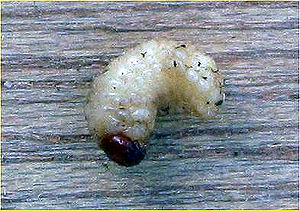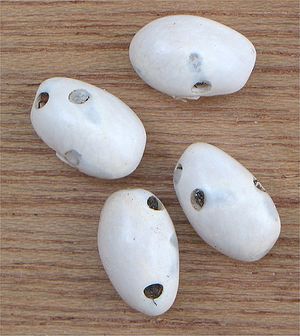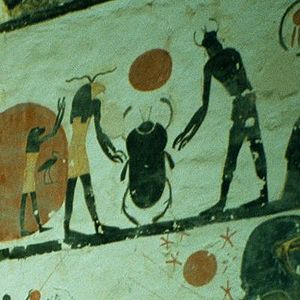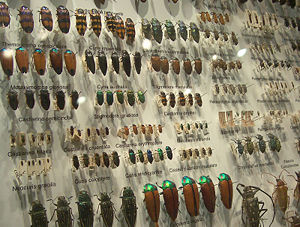Difference between revisions of "Beetle" - New World Encyclopedia
Rick Swarts (talk | contribs) |
Rick Swarts (talk | contribs) |
||
| Line 18: | Line 18: | ||
''See [[subgroups of the order Coleoptera]]'' | ''See [[subgroups of the order Coleoptera]]'' | ||
{{Taxobox end}} | {{Taxobox end}} | ||
| + | |||
| + | Note: This is only a rough draft, with notes. Please do not edit this article until the final draft is complete — i.e., when this notice is removed. You may add comments on what you would like to see included in the discussion area.[[User:Rick Swarts|Rick Swarts]] 19:41, 22 December 2005 (UTC) | ||
| + | |||
'''Beetles''' are one of the main groups of [[insect]]s. Their [[order (biology)|order]], '''Coleoptera''' (meaning "sheathed wing"), has more [[species]] in it than any other order in the entire [[animal kingdom]]. Forty percent of all described insect species are beetles (about 350,000 species), and new species are regularly discovered. Estimates put the total number of species — described and undescribed — at between 5 and 8 million. This is why, when [[J. B. S. Haldane]], a [[United Kingdom|British]] [[geneticist]], was asked what his studies of nature revealed about [[God]], he replied, "An inordinate fondness for beetles". | '''Beetles''' are one of the main groups of [[insect]]s. Their [[order (biology)|order]], '''Coleoptera''' (meaning "sheathed wing"), has more [[species]] in it than any other order in the entire [[animal kingdom]]. Forty percent of all described insect species are beetles (about 350,000 species), and new species are regularly discovered. Estimates put the total number of species — described and undescribed — at between 5 and 8 million. This is why, when [[J. B. S. Haldane]], a [[United Kingdom|British]] [[geneticist]], was asked what his studies of nature revealed about [[God]], he replied, "An inordinate fondness for beetles". | ||
Revision as of 19:41, 22 December 2005
Template:OtherUses
| Beetles | ||||||||||||||
|---|---|---|---|---|---|---|---|---|---|---|---|---|---|---|
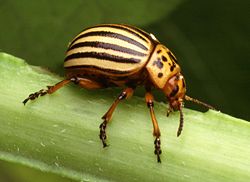 Colorado potato beetle, Leptinotarsa decemlineata | ||||||||||||||
| Scientific classification | ||||||||||||||
| ||||||||||||||
| Suborders | ||||||||||||||
|
Adephaga |
Note: This is only a rough draft, with notes. Please do not edit this article until the final draft is complete — i.e., when this notice is removed. You may add comments on what you would like to see included in the discussion area.Rick Swarts 19:41, 22 December 2005 (UTC)
Beetles are one of the main groups of insects. Their order, Coleoptera (meaning "sheathed wing"), has more species in it than any other order in the entire animal kingdom. Forty percent of all described insect species are beetles (about 350,000 species), and new species are regularly discovered. Estimates put the total number of species — described and undescribed — at between 5 and 8 million. This is why, when J. B. S. Haldane, a British geneticist, was asked what his studies of nature revealed about God, he replied, "An inordinate fondness for beetles".
Beetles can be found in almost all habitats, but are not known to occur in the sea or in the polar regions. They have a major impact on the ecosystem in three ways: feeding on plants and fungi, breaking down animal and plant debris, and eating other invertebrates. Certain species are agricultural pests in some areas, for example the Colorado potato beetle (Leptinotarsa decemlineata), while other species are important controls of agricultural pests, for example the lady beetles (family Coccinellidae) consume aphids, fruit flies, thrips, and other plant-sucking insects that damage crops.
Anatomy
Bearing in mind the wide diversity and number of species the anatomy of beetles is quite uniform. Beetles are generally characterised by a particularly hard exoskeleton, and the hard wing-cases (elytra) which tend to cover the hind part of the body and protect the second wings, the alae. The elytra are not used in flying, but generally must be raised in order to move the hindwings. In some cases the ability to fly has been lost, characteristically in families such as Carabidae and Curculionidae. After landing, the hindwings are folded below the elytra.
In a few families, both the ability to fly and the wing-cases have been lost, with the best known example being the "glowworms" of the family Phengodidae, in which the females are larviform throughout their lives.
The bodies of beetles are divided into three sections, the head, the thorax, and the abdomen, and these in themselves may be composed of several further segments.
The eyes are compound, and may display some remarkable adabtability, as in the case of the Whirligig beetles (family Gyrinidae), in which the eyes are split to allow a view both above and below the waterline. The dorsal appendage aids the beetle in stalking prey.
Antennae can vary greatly and may be filiform, claviform, flabellate or genticulate.
Oxygen is taken in via a tracheal system: this takes air in through a series of tubes along the body which is then taken into increasingly finer fibres. Pumping movements of the body force the air through the system. Although beetles have blood, it is not used for oxygen transference, although a heart is present.
Development
Beetles are endopterygotes with complete metamorphosis. The larva of a beetle is often called a grub and represents the principal feeding stage of the life-cycle.
The eggs of beetles are minute but may be brightly coloured, they are laid in clumps and there may be from several dozen to several thousand eggs laid by a single female.
Once the egg hatches the larvae tend to feed voraciously, whether out in the open such as with Ladybird larvae, or within plants such as with leaf beetle larvae.
As with lepidoptera, beetle larvae pupate for a period, and from the pupa emerges a fully formed beetle or imago.
In some cases there are several transitory larvae stages and this is known as hypermetamorphosis; examples include the blister beetles (family Meloidae).
Physiology
There are few things that a beetle somewhere will not eat, even inorganic matter may be consumed.
Some beetles are highly specialised in their diet; for example, the Colorado potato beetle (Leptinotarsa decemlineata) opts almost entirely to colonize plants of the potato family (Solanaceae). Others are generalists, eating both plants and animals. Ground beetles (family Carabidae) and rove beetles (family Staphylinidae) are entirely carnivorous and will catch and comsume small prey such as earthworms and snails.
Decaying organic matter is a primary diet for many species, this can range from dung which is consumed by coprophagous species such as the scarab beetles (family Scarabaeidae), to dead animals which are eaten by necrophagous species such as the carrion beetles (family Silphidae). The beneficial impact to the general ecology of these two activities is huge.
Various techniques are employed by many species for retaining both air and water supplies. Predaceous diving beetles (family Dytiscidae) may be the most common example, they employ a technique of retaining air when diving between the abdomen and the elytra.
Reproduction
The larval period of beetles varies between species but can be as long as several years. Adults have an extremely variable lifespan, again, from weeks to years.
Beetles may display some extremely intricate behaviour when mating. Smell is thought to play significant importance in the location of a mate.
Conflict can play a part in the mating rituals for example in species such as burying beetles (genus Nicrophorus) where localised conflicts between males and females rage until only one of each is left, thus ensuring reproduction by the strongest and fittest. Many beetles are territorial and will fiercly defend their small patch of territory from intruding males.
Pairing is generally short but in some cases will last for several hours. During pairing sperm cells are transferred to the female to fertilise the egg.
Parental care
As befitting such a large order, the parental care between species varies widely. It ranges from the simple laying of eggs under a leaf to scarab beetles, which construct impressive underground structures complete with a supply of dung to house and feed their young.
There are other notable ways of caring for the eggs and young, such as those employed by leaf rollers, who bite sections of leaf causing it to curl inwards and then lay the eggs, thus protected, inside.
Generally the number of eggs laid is an indicator of the level of parental care subsequently employed, as they are inversely proportional.
Predation
Beetles and larvae have evolved to employ a variety of different strategies for avoiding being eaten.
Many employ simple camoflage to avoid being spotted by predators. These include the leaf beetles (family Chysomelidae) that have a green colouring very similair to their habitat on tree leaves.
A number of longhorn beetles (family Cerambycidae) bear a striking resemblance to wasps, thus benefitting from a measure of protection. Large ground beetles by contrast will tend to go on the attack, using their strong mandibles to forcibly persuade a predator to seek out easier prey.
Many species, including lady beetles and blister beetles, can secrete poisonous substances to make them unpalatable.
Evolutionary history and classification
Beetles entered the fossil record during the Lower Permian, about 265 million years ago.
The four extant suborders of beetle are these:
- Polyphaga is the largest suborder, containing more than 300,000 described species in more than 170 families, including rove beetles (Staphylinidae), scarab beetles (Scarabaeidae), blister beetles (Meloidae), stag beetles (Lucanidae), and true weevils (Curculionidae). These beetles can be identified by the cervical sclerites (hardened parts of the head used as points of attachment for muscles) absent in the other suborders.
- Adephaga contains about 10 families of predatory beetles, includes ground beetles (Carabidae), predacious diving beetles (Dytiscidae) and whirligig beetles (Gyrinidae). In these beetles the testes are tubular and the first abdominal sternum (a plate of the exoskeleton) is divided by the hind coxae (the basal joints of the beetle's legs).
- Archostemata contains four families of mainly wood-eating beetles, including reticulated beetles (Cupedidae) and telephone-pole beetles (Micromalthidae).
- Myxophaga contains about 100 described species in four families, mostly very small, including skiff beetles (Hydroscaphidae) and minute bog beetles (Sphaeriusidae).
These suborders diverged in the Permian and Triassic. Their phylogenetic relationship is uncertain, with the most popular hypothesis being that Polyphaga and Myxophaga are most closely related, with Adephaga an outgroup to those two, and Archostemata an outgroup to the other three.
The extraordinary number of beetle species poses special problems for classification, with some families consisting of thousands of species and needing further division into subfamilies and tribes.
See the article subgroups of the order Coleoptera for a complete list of families.
Impact on humans
Pests
There are several serious agricultural and household pests represented by the order, these include :
- The Colorado potato beetle (Leptinotarsa decemlineata) is a notorious pest of potato plants. Adults mate before overwintering deep in the soil, so that when they emerge the following spring, females can lay eggs immediately, once a suitable host plant has been found. As well as potatoes, this can be any one of a number of plants from the potato family (Solanaceae) such as nightshade, tomato, aubergine and capsicum. Crops are destroyed and the beetle can only be treated by employing expensive pesticides, many of which it has begun to develop immunity to.
- The elm bark beetles, Hylurgopinus rufipes and Scolytus multistriatus (in the family Scolytidae) attack elm trees. They are important elm pests because they carry Dutch elm disease (the fungus Ophiostoma ulmi) as they move from infected breeding sites to feed on healthy elm trees. The spread of the fungus by the beetle has led to the devastastation of elm trees in many parts of the Northern Hemisphere, notably North America and Europe.
- The death watch beetle (Xestobium rufovillosum) is of some considerable importance as a pest of wooden structures in older buildings in Britain. It attacks hardwoods such as oak and chestnut, and always where some fungal decay has taken or is taking place. It is most usual for death watch beetle attacks to originate in timber of large dimensions, and it is thought that the actual introduction of the pest into buildings takes place at the time of construction.
- Asian long-horned beetle
- Citrus long-horned beetle
Beneficial organisms
- The larvae of lady beetles (family Coccinellidae) are often found in aphid colonies. While both adult and larval lady beetles found on crops prefer aphids, they will, if aphids are scarce, use food from other sources, such as small caterpillars, young plant bugs, aphid honeydew, and plant nectar.
- Large ground beetles (family Carabidae) are predators of caterpillars and, on occasion, adult weevils, whereas smaller species attack eggs, small caterpillars, and other pest insects.
Some farmers introduce beetle banks to foster and provide cover for beneficial beetles.
Scarab beetles in Egyptian culture
The scarab beetles (family Scarabaeidae) are coprophagous beetles.
It seemed to the ancient Egyptians that young scarab beetles emerged spontaneously from the burrow where they were born. Therefore they were worshipped as "Khepri", which means "he who came forth." This creative aspect of the scarab was associated with the creator god Atum. The ray-like antennae on the beetle's head and its practice of dung-rolling caused the beetle to also carry solar symbolism. The scarab beetle god Khepri was believed to push the setting sun along the sky in the same manner as the beetle with his ball of dung.
Many thousands of amulets and stamp seals have been excavated that depict the scarab. In many artifacts, the scarab is depicted pushing the sun along its course in the sky. During and following the New Kingdom, scarab amulets were often placed over the heart of the mummified deceased. The amulets were often inscribed with a spell from the Book of the Dead which entreated the heart to, "do not stand as a witness against me."
"Le Scarabée Sacré", the opening essay in Jean-Henri Fabre's famous Souvenirs Entomologiques, deals with the insect.
Collecting
The study of beetles is called coleopterology, and its practitioners coleopterists. See the list of list of notable coleopterists for more information.
There is a thriving industry in the collection of wild caught species for amateur and professional collectors.
Gallery
- Emerald ash beetle.jpg
Emerald Ash Beetle
- Cerambycidae Coleoptera California Prionus.JPG
California Prionus
- Beetle August 27-2005..png
Pelidnota punctata
ReferencesISBN links support NWE through referral fees
- Poul Beckmann, Living Jewels: The Natural Design of Beetles ISBN 3791325280
- Entomological Society of America, Beetle Larvae of the World ISBN 0643055061
- David Grimaldi, Michael S. Engel, Evolution of the Insects ISBN 0521821495
- Ross H. Arnett, Jr. and Michael C. Thomas, American Beetles (CRC Press, 2001-2)
- K. W. Harde, A Field Guide in Colour to Beetles ISBN 0706419375 Pages 7-24
Journals
- The Coleopterist (UK)
External links
Template:Dichotomouskey
- Goliathus.CZ - online insect museum, entomology, tips and tricks, how to spread and pin isect, etc.
- Goliathus.COM - Beetle breeding project, large gallery of beetles (more than 600 photos of 120+ species) available in several versions: chinese,japanese, deutsch, czech.
- http://www.coleopterist.org
- http://www.koleopterologie.de/gallery - Gallery of middle-European beetles
- Photogallery of beetles Large photogallery of tropical beetles.
- Coleoptera from the Tree of Life
- Australian borers species
- Superb Russian site
Credits
New World Encyclopedia writers and editors rewrote and completed the Wikipedia article in accordance with New World Encyclopedia standards. This article abides by terms of the Creative Commons CC-by-sa 3.0 License (CC-by-sa), which may be used and disseminated with proper attribution. Credit is due under the terms of this license that can reference both the New World Encyclopedia contributors and the selfless volunteer contributors of the Wikimedia Foundation. To cite this article click here for a list of acceptable citing formats.The history of earlier contributions by wikipedians is accessible to researchers here:
The history of this article since it was imported to New World Encyclopedia:
Note: Some restrictions may apply to use of individual images which are separately licensed.
